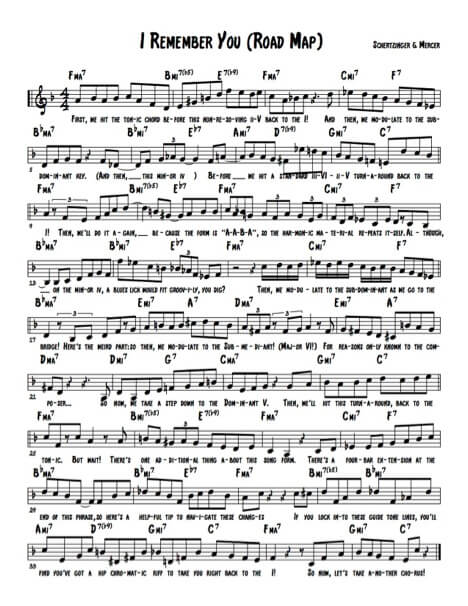Drafting a Roadmap to Effective Vocal Improvisation
By Justin Binek
In a previous article for the JEN e-newsletter (published in February 2017), I briefly discussed improvisational teaching strategies that I have used with singers at the collegiate level, focusing on some tools that I use to help students lock down the form of the tune and to incorporate lyricism and emotion in improvisation. This article will expand on those ideas, discussing the creation of “harmonic road maps” for achieving greater accuracy while improvising. Both this article and the previous one were derived from a clinic I presented at the 2015 JEN Conference in San Diego entitled “Successful Practice Room Strategies for Vocal Improvisation.”
Jazz Cartography: the “Harmonic Road Map”
One lesson that I try to impart to my students is that it is not just important, but VITAL to know the “harmonic road map” of the tune. In this, I am not referring to learning a tune’s structure chord-chord-chord-chord-chord, but where and how the tonal centers shift. In this, I approach thinking about harmony with a mixture of both jazz and classical perspectives (and since many of the singers I work with have been trained classically, this helps to bridge that gap a bit). For instance, an entry-level approach would be to take a tune like “Autumn Leaves,” and not think of it as Ami7-D7-GMa7-CMa7-F#mi7(b5)-B7-Emi7-etc., but rather the following:
First A Section
Bars 1-4: ii7-V7-I in Major
Bars 5-8: iiØ7-V7-i in the relative minor
Second A Section
Bars 9-12: ii7-V7-I in Major
Bars 13-16: iiØ7-V7-i in the relative minor
Bridge (B Section)
Bars 17-20: iiØ7-V7-i, still in the relative minor
Bars 21-24: ii7-V7-I in Major
Final A Section
Bars 25-28: iiØ7-V7-i in the relative minor, then descending half-step sequence to…
Bars 29-32: VI-V7-I, still in minor
This approach helps break down the tune into a contrast between Major and relative minor, and helps the beginning improviser develop a more musically coherent, harmonically sound approach right from the start.
Goal Notes: Signposts on the Harmonic Highway
The next level in this kind of “road mapping” involves taking a somewhat more complex tune and identifying what Shelton Berg refers to as the “goal notes.” (SIDE NOTE: I highly recommend Berg’s book Jazz Improvisation: The Goal Note Method for any improviser at any level.) In particular, when I work with singers who have classical training, I like to identify goal notes in terms of movable-Do chromatic solfeggio in relation to the tonic key. Once again, rather than think of a tune like “All of Me” only in exact chords (CMa7-E7-A7-Dmi7-etc.), I like to think of it this way:
| Bars | Relationship to Tonic | Goal Note (Solfeggio) |
| 1-2
7-8 15-18 21 23 29-32 |
I
Vi ii-V-I IV iii ii-V-I-turnaround |
All diatonic! |
| 3-4
9-10 19-20 |
III7 (V7/vi) | #5 (Si) |
| 5-6
21-22 24 |
VI7 (V7/ii) | #1 (Di) |
| 13-14 | II7 (V7/V) | #4 (Fi) |
| 22 | iv | b6 (Le) |
This particular approach helps the singer identify FOUR (that’s it!) specific goal notes that – when placed correctly on the road map – will help establish stronger harmonic and melodic soloing from improvisers (and though I keep referring to singers, this approach is also effective for instrumentalists as well, particularly those who play transposed instruments).
Adding Detail: Identifying the Boundaries
As the improviser becomes more comfortable (and the music gets more challenging), it becomes important to combine both the “tonal area” map with the “goal note” map for greater clarity. On a tune like “All the Things You Are,” I work with singers to think of how the tonal centers relate to each other, in the manner shown below:
A Section
Bars 1-5: vi-ii-V-I-IV in the tonic key
Bars 6-8: modulate up a major third, ii-V-I (the mediant key, if that helps)
B Section
Bars 9-13: vi-ii-V-I-IV in the dominant (V) key
Bars 14-16: modulate up a major third, ii-V-I (the leading tone key, if that helps)
C Section
Bars 17-20: stay in the current key, ii-V-I again
Bars 21-23: iiØ-V in the relative minor of the previous key, resolve to parallel I (Picardy 3rd)
Bar 24: Pivot chord to get back to the tonic key: III7alt (V7/vi)
A Section (recap, modified)
Bars 25-36: vi-ii-V-I-IV-iv-iii-#iidim-ii-V-I-turnaround
The four underlined chords above represent where the singer needs to be mindful of “goal notes,” having (hopefully!) navigated the changes in tonal center successfully. I have found, in guiding my students, that their solos on “All the Things You Are” take on stronger melodic direction and harmonic accuracy by taking this approach. When all is said and done, this approach boils the tune down to the following four concepts:
- Hear and know where the shifts in tonal center occur.
- Nail the Picardy 3rd at the end of the bridge (measure 23).
- The Picardy 3rd and the root of the chord in measure 23 turn into the 3rd and the #5 in the next chord. Common tones are your friend!
- Watch out for the chromatic bits near the end – grab the diatonic b6 (Le) in bar 30, and grab the diatonic #2 (Ri) and #4 (Fi) in bar 32, and you’re home free!
More Shifts = More Details for the Road Map
To finish things off, let’s take a look at how a more advanced singer might approach “I Remember You.” I’ve written out a vocalese that shows how a singer might navigate through the perils of the minefield of non-resolving ii-Vs, iv (minor) chords in Major, and unconventional modulations. This particular vocalese also identifies ways that the developing vocal improviser can add blues ideas and riffs (repetitive sequences) to assist in crafting a musically effective solo that also locks in harmonic ideas throughout the form. Enjoy this slightly humorous look at harmony and improvisation… And then have your students hit the practice room!

Justin Binek is a singer, pianist, teacher, composer/arranger, and clinician. He is an Assistant Professor of Music at Kansas City Kansas Community College, teaching Music Theory, Audio Engineering Music Skills, and Jazz Improvisation. Justin previously served as a Doctoral Teaching Fellow at the University of North Texas and taught at The University of the Arts (Philadelphia, PA) and the University of Mary (Bismarck, ND). He is a partner in the ProMusic Summer Camp at Tiffin University (Ohio), teaches on the faculty of the Halewynstichting Jazz Workshop (Belgium), serves on the NAfME Council for Jazz Education, and maintains an active performing career in both jazz and classical styles. For more information, visit www.justinbinekjazz.com, or contact him at [email protected].
